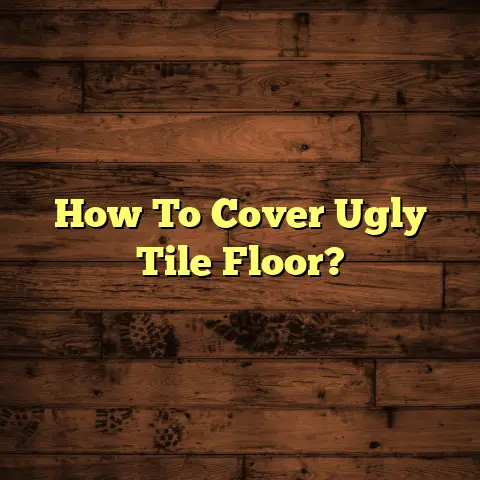Cost-Effective Bath Reno? (4 Budget Busters!)
I’m here to talk about something near and dear to my heart (and my wallet): bathroom renovations.
I’ve been in the flooring and renovation game for over 15 years, and I’ve seen it all – from dream bathrooms that stay on budget to absolute nightmares that leave homeowners in tears (and deep in debt).
Bathrooms are more than just functional spaces. They’re our personal sanctuaries, where we start and end our days.
They need to adapt to our changing needs and preferences over time.
But let’s be real. Bathroom renos can be expensive.
The key? Balancing aesthetics, functionality, and budget.
That’s why I’m here to help you navigate the murky waters of bathroom renovations and avoid the common pitfalls that can send your budget spiraling out of control.
In this article, I’m going to break down four major budget busters that I’ve seen time and time again.
I’ll also share some insider tips and tricks to help you stay on track and achieve the bathroom of your dreams without emptying your bank account.
Let’s dive in!
Understanding the Budget Busters
So, what exactly is a budget buster?
In the context of bathroom renovations, it’s anything that unexpectedly inflates your costs.
It could be anything from choosing overly expensive fixtures to uncovering hidden plumbing problems.
Budget busters are sneaky. They often start small but can quickly snowball into major financial headaches.
Trust me, I’ve seen projects go from a reasonable $5,000 estimate to a staggering $15,000+ because of unforeseen issues and poor planning.
That’s why it’s crucial to be aware of these potential pitfalls before you even pick up a hammer.
Think of it like this: a little preparation can save you a whole lot of pain (and money) down the road.
Budget Buster #1 – High-End Fixtures and Fittings
Okay, let’s talk about the shiny stuff: fixtures and fittings.
This is where a lot of homeowners get caught up in the excitement and end up blowing their budget.
We’re talking sinks, faucets, showerheads, toilets, and even towel racks.
The price range for these items can vary wildly.
You can find a basic faucet for around $50, but a high-end designer faucet can easily cost $500 or more!
And that’s just one faucet.
Multiply that by all the fixtures in your bathroom, and you can see how quickly the costs add up.
According to a 2023 report by HomeAdvisor, the average cost of bathroom fixtures ranges from $400 to $4,000, depending on the quality and brand.
I’ve seen homeowners spend upwards of $10,000 on fixtures alone!
The key is to find a balance between style and affordability.
You don’t have to sacrifice aesthetics to stay on budget.
There are plenty of stylish and affordable alternatives that won’t compromise on quality.
Here are a few tips to help you save money on fixtures:
-
Shop around: Don’t just settle for the first thing you see. Compare prices from different retailers, both online and in-store.
-
Look for sales and discounts: Many retailers offer seasonal sales or discounts on bathroom fixtures. Keep an eye out for these opportunities.
-
Consider open-box items: Some retailers sell open-box or refurbished items at a discounted price. These items are often in excellent condition and can save you a significant amount of money.
-
Don’t be afraid to mix and match: You don’t have to buy all your fixtures from the same brand or collection. Mix and match different styles and brands to create a unique look that fits your budget.
-
Prioritize: Decide which fixtures are most important to you and allocate your budget accordingly. For example, you might want to splurge on a high-quality showerhead but save money on a basic toilet.
I once worked with a client who was dead-set on having a $1,200 rain showerhead.
We ended up finding a similar model from a lesser-known brand for just $400.
She was thrilled with the look and performance, and we saved her $800!
Budget Buster #2 – Plumbing and Electrical Work
Alright, let’s talk about the stuff that’s behind the walls.
Plumbing and electrical work can be a major source of unexpected costs during a bathroom renovation.
These systems are complex, and even seemingly minor issues can require extensive repairs or upgrades.
Plumbing Problems:
Old pipes, leaky faucets, and outdated plumbing systems are common problems that can arise during a renovation.
According to the EPA, the average household leak can waste nearly 10,000 gallons of water per year!
Addressing these issues can be costly.
Rerouting plumbing lines can also add significant expenses.
If you’re planning to move the location of your toilet or shower, you’ll need to factor in the cost of rerouting the plumbing.
Electrical Upgrades:
Bathrooms require proper electrical wiring to ensure safety and functionality.
If you’re adding new lighting fixtures, outlets, or a heated floor, you may need to upgrade your electrical system.
This often requires permits and professional installation, which can be expensive.
Minimizing Costs:
So, how can you minimize plumbing and electrical costs?
-
Stick to the existing layout: The easiest way to save money is to keep the layout of your bathroom as close to the original as possible. Avoid moving the toilet, sink, or shower if you can.
-
Inspect your plumbing beforehand: Before you start the renovation, have a plumber inspect your plumbing system for any potential problems. Addressing these issues early can prevent costly surprises later on.
-
Get multiple quotes: Don’t just settle for the first plumber or electrician you find. Get quotes from multiple professionals to ensure you’re getting a fair price.
-
Consider DIY (with caution): Some minor plumbing and electrical tasks can be done yourself, but only if you have the necessary skills and experience. If you’re not comfortable working with plumbing or electricity, it’s best to leave it to the professionals.
I remember a client who tried to save money by doing the plumbing work himself.
He ended up flooding his entire bathroom and causing significant damage to the surrounding walls and floors.
In the end, he had to hire a professional to fix his mistakes, which cost him even more money than if he had hired a plumber in the first place.
Budget Buster #3 – Custom-Made Solutions
Ah, custom cabinetry.
The siren song of perfectly tailored storage and organization.
It’s tempting, I know.
But custom solutions can quickly drain your renovation budget.
The allure of custom-made solutions lies in their ability to perfectly fit your space and meet your specific needs.
However, this level of customization comes at a premium.
Cost Differences:
Custom cabinetry can easily cost two to three times as much as pre-fabricated options.
According to a 2022 survey by the National Kitchen and Bath Association (NKBA), the average cost of custom cabinetry is around $20,000, while pre-fabricated cabinets can cost as little as $5,000.
That’s a huge difference!
Case Studies:
I once worked with a client who wanted custom-built vanities with intricate carvings and a specific stain.
The initial quote for the vanities was $15,000.
We ended up finding pre-fabricated vanities with a similar style and finish for just $4,000.
She was thrilled with the look and saved $11,000!
Alternatives:
So, what are some alternatives to custom solutions?
-
Pre-fabricated cabinets: Pre-fabricated cabinets come in a wide variety of styles, sizes, and finishes. They’re a much more affordable option than custom cabinets.
-
Semi-custom cabinets: Semi-custom cabinets offer a balance between custom and pre-fabricated options. They allow you to customize certain aspects of the cabinets, such as the door style and finish, without the high cost of fully custom cabinets.
-
Repurpose existing furniture: Consider repurposing existing furniture, such as a dresser or console table, into a vanity. This can be a creative and cost-effective way to add storage to your bathroom.
-
Open shelving: Open shelving is a stylish and affordable way to add storage to your bathroom. It’s also a great way to display decorative items.
Long-Term Value:
When considering custom solutions, it’s important to weigh the long-term value against the initial cost.
Will the custom solution truly add value to your home, or is it simply a luxury item?
Will it stand the test of time, or will it become outdated in a few years?
Budget Buster #4 – Overlooking the Importance of Planning
Last but definitely not least, we have the silent killer of bathroom reno budgets: lack of planning.
I can’t stress enough how important it is to plan your bathroom renovation thoroughly before you start any work.
A lack of planning can lead to costly mistakes, miscalculations, changes mid-project, and delays.
Trust me, I’ve seen it happen countless times.
Effective Planning:
So, what constitutes effective planning?
-
Timelines: Create a realistic timeline for your renovation project. Factor in time for demolition, plumbing, electrical work, tiling, painting, and installation of fixtures.
-
Budget Estimates: Develop a detailed budget that includes all the costs associated with your renovation, including materials, labor, permits, and contingency funds for unexpected expenses.
-
Design Considerations: Carefully consider the design of your bathroom. Think about the layout, style, color scheme, and functionality.
-
Professional Consultation: Consider consulting with a professional designer or contractor to help you plan your renovation. They can provide valuable insights and help you avoid costly mistakes.
-
Visualization: Use design software or create a mood board to visualize the space before making any decisions. This will help you ensure that the design meets your needs and preferences.
Benefits of Planning:
The benefits of thorough planning are numerous:
-
Reduced Costs: Planning helps you avoid costly mistakes and ensures that you stay within your budget.
-
Time Savings: Planning helps you stay on schedule and avoid delays.
-
Improved Results: Planning helps you achieve the desired results and create a bathroom that meets your needs and preferences.
I had a client who skipped the planning phase altogether.
She started tearing down walls without having a clear idea of what she wanted the finished bathroom to look like.
She ended up making several costly mistakes and had to hire a contractor to fix her messes.
In the end, her renovation cost twice as much as it should have, and she wasn’t even happy with the results.
Allocate Time and Resources:
Don’t underestimate the importance of the planning phase.
Allocate sufficient time and resources to planning to avoid budget overruns and ensure a successful renovation.
Conclusion
So, there you have it – the four major budget busters that can derail your bathroom renovation project.
Remember, with careful consideration and planning, you can navigate these challenges and achieve your desired results without overspending.
The key is to approach your bathroom renovation with a mindset of adaptability.
Be willing to make compromises and adjust your plans as needed.
Ensure that your new space meets both your current and future needs.
Don’t let the fear of budget busters paralyze you.
Embrace the challenge, do your research, and plan carefully.
With a little bit of effort and preparation, you can create the bathroom of your dreams without breaking the bank.
Now go forth and renovate!
I hope this article has been helpful.
Feel free to reach out if you have any questions or need any further advice.
Happy renovating!





